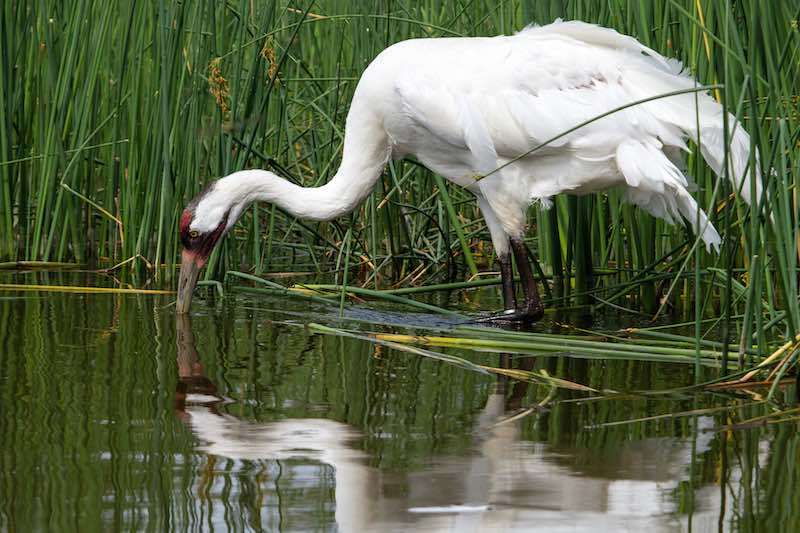Among the signs of springtime these days in central Wisconsin is the arrival of wild whooping cranes on Necedah National Wildlife Refuge and along the rivers and wetlands these majestic birds call their summer homes.
Thanks to the efforts of the Whooping Crane Eastern Partnership (WCEP), there are now 64 endangered whooping cranes migrating across the skies of eastern North America for the first time in more than a century using their eastern ancestral route.
Biologists with WCEP, an international coalition of public and private groups, announced today that 15 reintroduced whooping cranes had arrived on or near Necedah, and two others were roosting along the Wisconsin River.
Whooping cranes were on the verge of extinction in 1941, down to a low of just 21 birds. Today, about 300 birds exist in the wild. Aside from the 64 Wisconsin birds, the only other migrating population of whooping cranes nests at the Wood Buffalo National Park in Northwest Canada and winters at an Arkansas refuge on the Texas Gulf Coast. A non-migrating flock of approximately 60 birds also lives year-round in the central Florida Kissimmee region.
The migrations began, as WS reported in 2001, when pilots, like surrogate parents, first led whooping crane chicks, who had been conditioned to follow, away from Necedah in their ultralight aircraft (disguised to look similar to a crane). The same technique was featured in the movie, Fly Away Home. Each subsequent year, WCEP biologists and pilots have conditioned and guided other groups of juvenile cranes southward on the 1,250 mile journey (40-70 days) to central Florida.
The whooping crane chicks that take part in the reintroduction project are hatched at the Patuxent Wildlife Research Center in Laurel, Md., where they are introduced to ultralight aircraft and raised in isolation from humans. To ensure the impressionable cranes remain wild, project biologists and pilots adhere to a strict no-talking rule, and use recorded adult crane calls to communicate with the young birds. Researchers wear costumes designed to mask the human form whenever they are around the cranes.
New classes of cranes are taken to Necedah each June to begin a summer of conditioning behind the ultralights to prepare them for their fall migration. Pilots lead the birds on gradually longer training flights at the refuge throughout the summer until the young cranes are deemed ready to follow the aircraft over Illinois, Indiana, Kentucky, Tennessee, Georgia, and into Florida.
The 19 birds in the Class of 2005, the most recent ultralight- reintroduced cranes, arrived in Florida on Dec. 13, 2005, after a 64-day migration. The 19 remain at their pensite in Florida and have begun taking short evening flights in the immediate area of the pen.
In addition to the 19 chicks that migrated behind ultralights in 2005, biologists also released four additional chicks last fall into the company of older birds at Necedah, in the hopes that the chicks would learn the migration route from adult whoopers or sandhill cranes.
WCEP is using this "direct autumn release" technique to complement the known success of the ultralight-led migrations. The chicks are reared in the field and released with older birds after fledging, or developing their flight feathers. This method has proven successful with sandhill cranes.
As of March 24, two of the 2005 direct autumn release birds had embarked on migration and were in Indiana; the other two remain in Florida.
Project staff from the International Crane Foundation and the U.S. Fish and Wildlife Service track and monitor cranes in an effort to learn as much as possible about their unassisted migrations back up North, and the habitat choices they make along the way. Wisconsin DNR biologists, join them in monitoring the cranes while they are at their summer locations, in 35 of 72 Wisconsin counties.
Whooping cranes, named for their loud and penetrating unison calls, live and breed in wetlands, where they feed on crabs, clams, frogs and aquatic plants. They are distinctive animals, standing 5 feet tall, with white bodies, black wing tips and red crowns on their heads.
Many other states, provinces, private individuals and conservation groups
have joined forces with and support WCEP with funding and personnel and by donating resources, like opening up private lands for the cranes along the migration route. More than 60 percent of the project’s budget comes from private sources in the form of grants, donations and corporate sponsors.
For more information on the project, like what to do if you see a Whooping crane, and to see the amazing photo of the ultralight disguised as a crane, visit the WCEP website at www.bringbackthecranes.org.
Photos by Jason Mrachina, CC (top) Whooping Crane Eastern Partnership (middle)










Be the first to comment